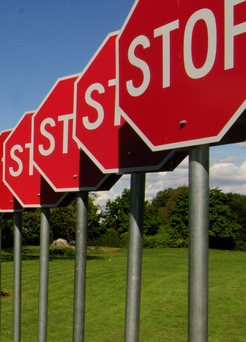Reader question: Cutting losses quickly or properly?
Reader Dan asks, in response to this post:
Good article. A few questions/comments. Define "cut losses quickly?" If you are trading pullbacks and you set a stop loss that would signify the pattern has failed, would that not be "cutting losses quickly"? I can see how a trader might take such a comment and introduce a level of dabbling in ones trading that would produce mental turmoil. For example, a pullback starts sputtering and the trader closes the position only to see the trade go in his direction. The opposite is true as well. Is not setting your stops and targets based on your risk management principles and letting the trade play out a more consistent approach?
[dc]A[/dc]bsolutely. I think you've hit on one of the critical elements of trading: we have to give trades "enough room". What is "enough room"? It will vary with the market, but it's at least clear that it has to somehow incorporate the volatility of the market being traded--more volatile markets will require more room (larger stops) than less volatile markets. You can certainly quantify that in many different ways, and I might suggest that this is a case where ATR or other "range-aware" measures of volatility are probably better than, say, historical volatility. Why? Because historical volatility is calculated from the standard deviation of closes, and you are going to execute your stops if they are violated intrabar (probably), meaning that you will be responding to market information based on highs and lows of each bar. Since historical volatility doesn't see highs and lows, it might be a slight logical disconnect to use it in this context.

So, it's clear we can't put our stops extremely close to the market, in what would essentially be the noise of the market. As a general rule of thumb, stops placed less than 1 ATR are probably just silly, with a few exceptions. Beyond that, you can adjust and tweak for elements of your style and the pattern you are trading.
Very close stops actually carry very large risk. This is one way that a lot of the marketing done to beginning traders is really disingenuous: it's so common to see people talk about "low risk trades". There's no such thing as a low risk trade, if you are sizing everything appropriately. If you have a very tight stop you will have a very large position size, and that, ironically, can represent very large risk, especially on a gap. If you do have a low risk trade, you also have a low reward trade, so what are you doing? Why waste your time with a small exposure that takes a disproportionate amount of mental and emotional capital for the potential financial return? If you truly understand probability, you will see that tight stops are very rarely a good thing, as I discussed in this post. As I said there, "good risk management means using the proper stop, not necessarily a very tight stop."
Cutting losses quickly means cutting losses appropriately. For some traders, this may mean minutes; for others, it could mean weeks. I do think one of the key trading skills is allowing markets to fluctuate appropriately--giving trades enough room. There has to be a point at which you can step back and let the market move. People who can't do that find themselves getting into trades, getting nervous, and then pretty immediately doing something silly like exiting and getting right back in. Don't do that, but it is even more devastating to let a market go beyond your intended stop point. You can't do that very often without really damaging your performance.
It's really about doing the right thing, but there are two parts to that: first, you have to know what the right thing is. This means you have to understand how markets move, what works and what doesn't, and how probabilities and statistics rule your trading results. Second, you have to do the right thing. You have to be able to monitor and control your behavior, and execute your plan with perfect discipline. Thank you for the excellent question!



